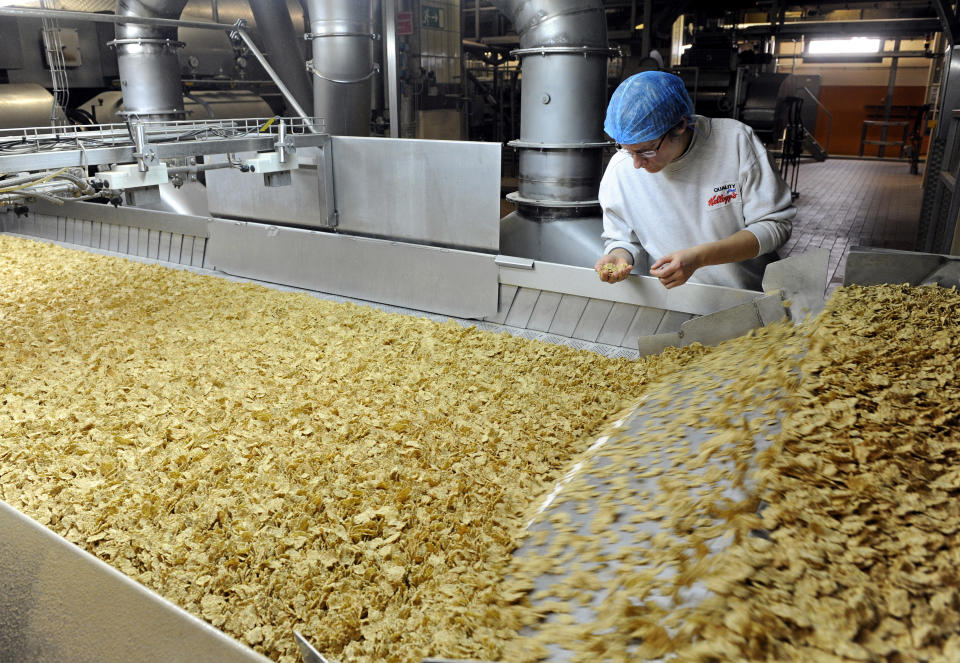Kellogg CEO on managing a 114-year-old cereal giant through COVID-19
Similar to other storied consumer goods brands such as Hormel and General Mills, it has been far from normal times for 114-year-old cereal and snacks giant Kellogg (K) smack in the middle of a raging pandemic.
With seemingly the entire world eating from home while working on Zoom calls, Kellogg’s once steady Eddie sales have gone through the roof in the matter of months. More Eggo waffle boxes in freezers perhaps than ever before. More bowls of Frosted Flakes than perhaps ever before. Pop Tarts are now as hot a seller as BTS downloads on iTunes (or somewhere in the vicinity, maybe).
The full-on demand frenzy has led Kellogg to run its manufacturing plants 24/7 to keep the country fed. So far so good on that front — Kellogg has not seen the rampant out of stocks in its food offerings as say, those evidenced at Tyson Foods.
For veteran consumer goods executive and Kellogg Chairman and CEO Steve Cahillane, this environment is something like he has never seen before. It has tested the leadership skills he has honed through executive-level stints at Nature’s Bounty, Coca-Cola and AB InBev. And naturally, it has tested Kellogg’s (which has supplied the country with food during World Wars, the Depression and other bouts of insanity) ability to get people their daily nutrition.
“On the one hand you are obviously concerned about the world, employee safety, and your family’s safety. All these things. And at the same time we realized we have a contribution to make here. We sell packaged food that people love and at this moment, people really need,” Cahillane told Yahoo Finance on managing through the early stages of the pandemic. “It was definitely a wow factor when you are looking at high double-digit growth for brands that had been pretty steady. But at the same time, there is a lot of inspiration that comes from meeting the moment and being a part of a company that plays an important role in the moment. So there were a lot of emotions circling around at that time when the pandemic first hit and still continuing today.”
Investors are weeks removed from getting a taste of how the pandemic has re-shaped Kellogg’s financial statements.

Kellogg’s second quarter organic net sales rose 9.2% from the prior year to $3.6 billion. Adjusted operating profits improved 24.7% from a year ago to $562 million. Diluted earnings per share rose to $1.24 from $0.94 last year. Some perspective here: Kellogg’s organic net sales increased 1.9% in 2019. Adjusted earnings per share fell 9%.
To be sure, North America was the clear standout for Kellogg in the second quarter. Sales increased 1% and operating profit surged by 44% on the back of those aforementioned Pop Tarts and Eggo waffles. Cereal sales also notched strong gains.
The company lifted its full-year sales and earnings outlooks. It now sees full year organic net sales growth of 5% compared to a prior increase of 1% to 2%. Adjusted earnings per share are expected to fall 1%. Previously, Kellogg’s forecasted a 3% to 4% decline.
Although most packaged food analysts on Wall Street continue to fret over demand cooling off big-time later this year as people slowly return to work, Cahillane says consumers are still consuming a great deal of his product offerings at the moment. His comments are consistent with other food industry executives Yahoo Finance has talked with lately. While sales may not be growing at the double-digit clips seen at the height of the pandemic, new lifestyle habits among consumers have kept sales of packaged foods at a higher steady state.
“Well, it's [consumer demand] clearly still above pre-pandemic levels, but we expected it to come down and in many ways you almost hope it comes down because it means the world is coming back to normal. But in our second quarter results call, we did say we expected deceleration in the third quarter because people are not going to be at home 24/7, so they're going to be out on the go. And they'll be eating in restaurants and from convenience stores and things like that. And so we expected it to decelerate which it has — it hasn't gotten all the way back to normal. However, you're still seeing elevated at home consumption, which we can all see just by looking around at our own family, friends and neighborhoods,” explains Cahillane.
Brian Sozzi is an editor-at-large and co-anchor of The First Trade at Yahoo Finance. Follow Sozzi on Twitter @BrianSozzi and on LinkedIn.
Coca-Cola CEO: here’s what our business looks like right now
Dropbox co-founder: the future of work will be all about this
Follow Yahoo Finance on Twitter, Facebook, Instagram, Flipboard, SmartNews, LinkedIn, YouTube, and reddit.


